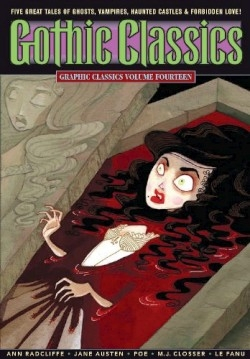Gothic Classics
Five Great Tales of Ghosts, Vampires, Haunted Castles & Forbidden Love
The mysterious stranger with hypnotic eyes, the spooky, candlelit castle with strange nighttime sounds, the disturbing family secret, and the supernatural threat… all are part of the Gothic, the genre of romantic mystery that sparked the imaginations of impressionable young women of the nineteenth century. Turning the classic stories found here into comics gives them life for a new generation.
Editor Pomplun has been releasing collections of illustrated public domain works for five years, and this volume is number fourteen in the Graphic Classics series. First in the book is J. Sheridan Le Fanu’s Carmilla with art by Lisa K. Weber. Le Fanu has been called the father of the modern ghost story, and this vampire tale, in which Laura is befriended by the strangely attractive, demonic Carmilla, influenced Bram Stoker’s Dracula. The black-and-white shading demonstrates pencil marks, a handmade touch that reinforces the diary-style narration. It’s used to particularly good effect when a ghostly Carmilla visits Laura in her bed.
Ann Radcliffe’s The Mysteries of Udolpho is drawn by Carlo Vergara. His crisp linework wonderfully captures subtle moments, as when Emily takes pleasure in simply sitting next to the young man she’s fallen in first love with as their coach returns to her home. Her quiet smile as she looks out the window says more than the narration alone could. The supposedly supernatural happenings, such as a corpse awakening, are more believable because the presentation is so straightforward. The story has influenced hundreds of romance novels and horror stories, and two of the works included here even allude to it by name.
Poe’s The Oval Portrait is a short four pages, with art by Leong Wan Kok. At its length, it’s merely an incident in which a traveler in a deserted castle discovers the tragedy behind a beautiful portrait, but the events narrated are the creepiest in the book. Unfortunately, the round heads and circle eyes of the cartoonish characters would have been more effective if they looked as if they belonged in a moody horror story instead of a four-panel newspaper strip.
Austen’s gothic parody Northanger Abbey is the most famous story of those included, and it’s the best here, largely due to the beautiful illustrations by Anne Timmons. As with all Austen, the conversation sparkles, whether it’s two young ladies discussing how “deliciously horrid” the novels they’re reading are or an insightful young man pointing out how changeable a flirt can be. Timmons’ art enhances the text with just the right facial expressions: shyly downcast eyes during an introduction, cheerful smiles while walking with a well-favored young man, shocked dismay at hearing of a friend’s tragedy.
In all of the stories, the supernatural is suggested instead of shown in detail, an approach which gives them power still to disturb and involve the reader. Illustrated stories provide valuable reference in terms of period costume and the like, reminding the reader of Victorian times.
Reviewed by
Johanna Draper Carlson
Disclosure: This article is not an endorsement, but a review. The publisher of this book provided free copies of the book to have their book reviewed by a professional reviewer. No fee was paid by the publisher for this review. Foreword Reviews only recommends books that we love. Foreword Magazine, Inc. is disclosing this in accordance with the Federal Trade Commission’s 16 CFR, Part 255.

